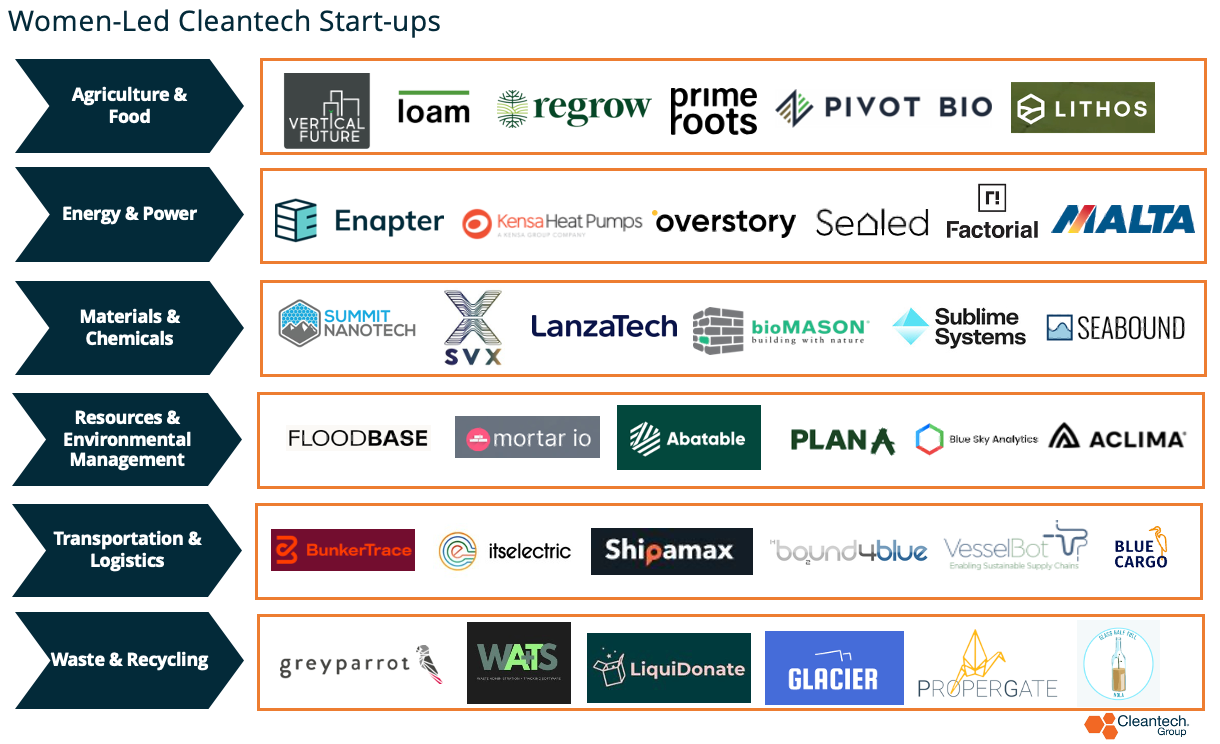Powering the Future: Women Leading the Charge Towards Net-Zero
Reaching net-zero emissions by 2050 requires both concerted policy and funding efforts to scale up clean technologies. Most importantly, it requires a diverse workforce spanning various sectors and industries which will lead these efforts. Climate scientists, sociologists, engineers, technologists, innovators, policymakers, sustainability advocates, entrepreneurs, investors, and business leaders, educators, communicators, farmers, health workers are just some of the disciplines that will contribute to our net-zero future.
In celebration of International Women’s Day, we would like to extend our appreciation to women-led cleantech start-ups for their invaluable contributions, showcasing the diverse talents, expertise, and innovative approaches across different cleantech sectors in tackling this crucial endeavor.

With every industry becoming a climate industry, this year we are showcasing nine female leaders coming from different sectors of the economy all working towards accelerating the clean energy transition.
Mónica Andrés Enríquez, Executive Vice-President for Europe, Yara
Mónica started her career in climate working as an agronomist in the field. It was there that she recognized the urgent need for businesses to prioritize sustainability and reduce their environmental impact. This intrinsic motivation led her to Yara, whose mission is to responsibly feed the world while protecting the planet. Looking back to her twenty-five years as an agronomist and her current role as EVP of a company in a predominately male-dominated sector, her advice to any woman considering a cleantech career is, “Don’t blend in, stand up!”. For Mónica, this means refusing to blend into the culture and norms and standing up for your values, becoming a model of change for society and for the world.
When it comes to reaching net-zero, Mónica stresses the importance of collaboration and the urgent need to scale up technological advancements and innovative solutions that already exist. Take for example her favorite cleantech: ultra-low-carbon fertilizers, which can reduce the carbon footprint of certain crops by between 10 – 30%. While the technology is already available today to produce clean ammonia and nitrogen fertilizers from renewable energy, policy incentives and new business models are needed for a viable business case.
Ewa Jackson, Managing Director, Sustainable & Transition Solutions, BlackRock
After spending more than a decade in banking, Ewa got involved in sustainable and transition investing when she joined BlackRock seven years ago. As a problem solver with a knack for making things simple, sustainable investing was a natural next move for her as the transition to a low carbon economy is one of the most complex societal issues.
In her role, Ewa finds it energizing to work with some of the world’s most sophisticated investors and to support them as they think through complex topics such as shifting profit pools, evolving technology risk, and what this means for a portfolio’s risk / return profile. Ewa is a vocal advocate of fostering inclusive workplaces and lifting up other women, most recently co-chairing BlackRock’s Women’s Initiative, representing over 2,500 members.
In her perspective, there are three necessary qualities for a woman considering a career in climate:
- Resilience to overcome obstacles.

- A growth mindset.

- For climate investing in particular, the need for “energy” as this is such a fast-moving field, and one needs to constantly be learning and proactively ideating creative solutions.
When asked about the biggest challenge to reaching net-zero, Ewa says that would require more flexible capital, long-term support to companies working on scaling up low carbon solutions, and more investment in emerging markets. In regard to her favorite cleantech innovation, it is very difficult to choose just one but circular solutions, such as sustainable energy derived from organic waste is a favorite.
Anna J. Siefken, Deputy Director, Federal Energy Management Program (FEMP), Office of Infrastructure, U.S. Department of Energy
When Anna graduated from Duke University with a liberal arts degree in History of Art and Architecture, she could not have imagined she would spend most of her career in clean energy. Early on, a pivotal role was to help launch one of the U.S.’ first e-commerce websites for The Home Depot, and her purview included energy efficiency. She characterizes this experience as a lucky one, because it gave her the opportunity to collaborate with a myriad of energy stakeholders from contractors to manufacturers to government agencies. From this role, she moved into positions of increasing responsibility, including program design and procurement. Each role sharpened her focus and led her to her current position as Deputy Director of FEMP.
The word ‘collaboration’ is key for Anna because she believes it is critical for the transition to a clean energy economy. The evolution, she says, starts with changing purchasing behaviors and empowering decision-makers to make sustainable choices based on the longer-term investment, not simply the lowest first cost. Anna sees the biggest challenges to reaching net-zero as building awareness and educating “consumers” – at work and at home – on the impact and critical importance of reaching carbon neutrality, and then the path to get there.
Anna underlines that in the U.S., the needle is moving with the passing of the Inflation Reduction Act and the Bipartisan Infrastructure Law, both of which are driving innovation, creating new clean energy jobs, and accelerating decarbonization initiatives beyond expectations. Having served in the private and public sectors, Anna believes that making a climate impact in any role is possible if you have a plan, and you work toward it. “Transitioning the world toward clean energy means changing hearts and minds. It’s like steering an enormous ship onto a new course—it demands perseverance, determination, and an unwavering belief in our ability to forge a sustainable future.”
Her advice for women considering a career in climate is to dive in, maximize all opportunities regardless of the role or company, and ask the hard questions. As for her favorite cleantech innovation, she says that since we don’t know what the next revolutionary idea will be, there is only one thing to do: pick the most promising technologies and deploy, deploy, deploy!
Dörte Hirschberg, Partner, Climentum Capital
Long before she started a career in venture capital, Dörte had already helped automotive and energy industries digitalize at McKinsey, led the company incubator Rocket Internet, and founded her own software company. It was in 2020 during the COVID-19 pandemic when she decided that she wanted to focus on investing following her first successes as an angel investor. By the time she decided to professionalize her interest in VC, she was pregnant with her second child and there was significant pushback from existing VC funds on how she could balance motherhood with the fast-moving environment of venture capital. Hence, she decided to start her own VC fund with three international partners.
When asked for her career advice to women interested in working in climate, Dörte emphasizes that there is no one-size-fits-all advice. It helps to get structured mentoring and training early in your career through working in consulting, investment banking, and a corporate environment to gain versatile skills and build a good network.
When it comes to her favorite cleantech solution, she underscores that there is no silver bullet — we need all types of technologies to work to reach our climate goals. When pressed to pick one solution, she went for fusion energy, which has the potential to provide carbon-free energy at scale. Luckily, Dörte has invested in Novatron Fusion which could make that happen by 2030.
Kendra Rauschenberger, General Partner, Siemens Energy Ventures
In 2007, Kendra’s career took a climate turn. She moved to Brande, Denmark to take a role in the Wind Service business of Siemens Wind Power (now Siemens Gamesa Renewable Energy). Her motivation behind focusing on the wind industry was simple: she wanted to learn more about this emerging field and make a difference. Kendra says that it was her formative years in the wind industry that made her the business operator she is today.
The second turn of her climate career was when her children were born. Her second maternity leave coincided with the carve out of Siemens Energy from Siemens AG. Siemens Energy in this new phase needed to find impactful ways to collaborate with the start-up ecosystem through building a new corporate venture unit. It took Kendra only one second to say yes to the opportunity of building this unit from scratch. As for her advice for women considering a cleantech career, it is simple:
- Go for it.

- Find your tribe.

- Find how your own superpower can contribute to the fight against climate change.
For Kendra, the biggest challenge to reaching net-zero emissions is how to manage this transition from a planetary and people perspective. As for this one cleantech innovation that can catapult the energy transition, Kendra chose wireless power transmission, as it can enable seamless charging of vehicles, UAVs or factory robots, but also power remote locations, or applications and optimize the use of renewable resources.
Kajsa Ryttberg-Wallgren, Executive Vice President, Head of Business Unit Hydrogen, H2 Green Steel
With a natural science background, Kajsa saw a career in heavy industry as the natural next step. As a problem solver and an avid dealmaker, she quickly developed a passion for solving one of the most pressing global issues — how to green heavy industry — and dedicated her career to it. Having served in leadership positions in several companies with household names, in 2021 she decided to join H2 Green Steel, a trailblazing cleantech company on a mission to decarbonize steel production.
One thing that attracted Kajsa to H2 Green Steel is that there is no such thing as an idea that is too big. If you have a great idea at the company, and can find a business case for it, you can see it being implemented. As the only woman in the room for most of her career, she says that sponsorship is key to advancing women in leadership positions. She recalls that it was a combination of skills and sponsorship from a senior female leader at Sandvik that paved the way for her to get her first leadership role.
When it comes to what it would take for Europe to decarbonize, she says that the biggest challenge is that in most places where industrial facilities are in Europe, access to renewables is not ideal. This means that to electrify, you would have to relocate some parts of the value chain. Her favorite cleantech solution is electrolysis. Luckily, through electrolysis, H2 Green Steel could reduce CO2 emissions globally as it currently is exploring operations not only in Europe, but also in the U.S., Canada, and Brazil.
Ramya Swaminathan, CEO, Malta Inc.
Ramya has spent her career focusing on the energy industry from different standpoints. Her first job upon graduation was in investment banking, where she worked on the financing side of power plants. The financial crisis of 2008 prompted her to leave banking and take a leap into energy entrepreneurship. She co-founded a hydropower development company and grew that company into the leading platform for new hydropower on existing dams in the U.S. This experience set the foundations for the next step of her career as CEO at Malta Inc.
Malta’s technology was incubated at X, Alphabet’s (then Google’s) Moonshot Factory. When she first met the team at X, they told her to “think about Malta like pumped storage hydropower but without the hydropower.” When X made the decision to spin the company out as an independent entity, they asked Ramya to lead the spinout, and she has been the CEO ever since.
As one of the few female cleantech CEOs, we asked Ramya about her advice for women interested in a career in cleantech. Ramya stressed that cleantech has all the excitement of other technology sectors, but it also allows you to help to save the world. When we asked Ramya about what she foresees as the biggest challenge to reaching net-zero, she said it is regulatory speed. Ramya’s favorite cleantech innovation: white roofs which reduce the need to run air conditioners and fans. If deployed at scale, this could have the same impact as removing 300 million cars from the roads for 20 years.
Afkenel Schipstra, Hydrogen Lead, Uniper Benelux
Growing up on the Caribbean Island of Curaçao, a place where an oil refinery was central to the local economy, for Afkenel it was natural to dive into the energy sector. She first started her career at an oil and gas company before committing herself to making green hydrogen a viable and accessible solution.
In her current role at Uniper, she leads on all things hydrogen and architects strategies to make the company carbon neutral by 2035. With green hydrogen being part a key vector in every credible decarbonization scenario out there, when we asked Afkenel what she foresees as the biggest challenge to a net-zero future, she highlighted the transition from a fossil fuel-based economy to one powered by renewables. Why? This shift requires overcoming entrenched interests, addressing socioeconomic impacts, and investing in renewable infrastructure to ensure competitiveness and scalability.
Her advice to any woman considering a career path in cleantech is to go for it, surround yourself with mentors, and don’t let stereotypes hold you back. While it’s true that the industry is still largely male-dominated, women bring invaluable perspectives and expertise to the table, she adds.
Her favorite cleantech is the development of large-scale underground hydrogen storage facilities, which are key to providing clean energy when the sun is not shining, and the wind is not blowing. The good news is that Uniper Storage in Germany is already working to make this a reality.
Beatriz Yordi, Director of European’s Commission Directorate General for Climate Action, leading the team responsible for the EU Emissions Trading System
Beatriz studied physics and began her career at the Research Centre CIEMAT. She then worked as a young Chief Engineer in Endesa-RWE and Notary’s joint venture where she was in charge of designing and constructing the first European solar PV plant. Following a career in industry, she moved to the European Commission where she leads designing and implementing policies which cover the whole spectrum of clean energy including photovoltaics, the first European legislation on renewable energy, green business building, climate mitigation, emissions trading, and CO2 standards for vehicles.
For Beatriz, it was quite obvious that an energy system solely relying on fossil fuels would not be sustainable in the long term. And that is exactly the reason we need global cooperation, policy consistency, enabling conditions, fair social policies, and innovation to transition to a clean energy system, she stresses. As a person with a front row seat in energy policy, Beatriz notes that many things have changed since she first started her career when it comes to gender balance in energy roles.
Her advice for women considering a career in climate is that we need all scientific backgrounds as climate change is a multidimensional challenge. On top of that, she underlines that working in climate also requires:
- Enjoying what you do.

- Pushing forward.

- No fear of complexities.
As for her favorite cleantech, she says that diversification is her guiding principle: we need all technologies from hydrogen to biomass and carbon removals to reach net-zero.
Upcoming Webinar

March 26, 2024
11:00 AM EST | 8:00 AM PST | 4:00 PM GMT
There is no shortage of news headlines highlighting the exciting developments in artificial intelligence, but questions about how AI can accelerate the clean economy transition remain. Cleantech Group and CleanAI have published a new report, Cleaning Up With AI, covering application areas and the potential sustainability impact of AI on cleantech innovation across five industry verticals. Of the almost $30B of risk capital invested in the last six years, 70% has been in early-stage innovators – an additional $138B will be required in the next six years to support further growth.


